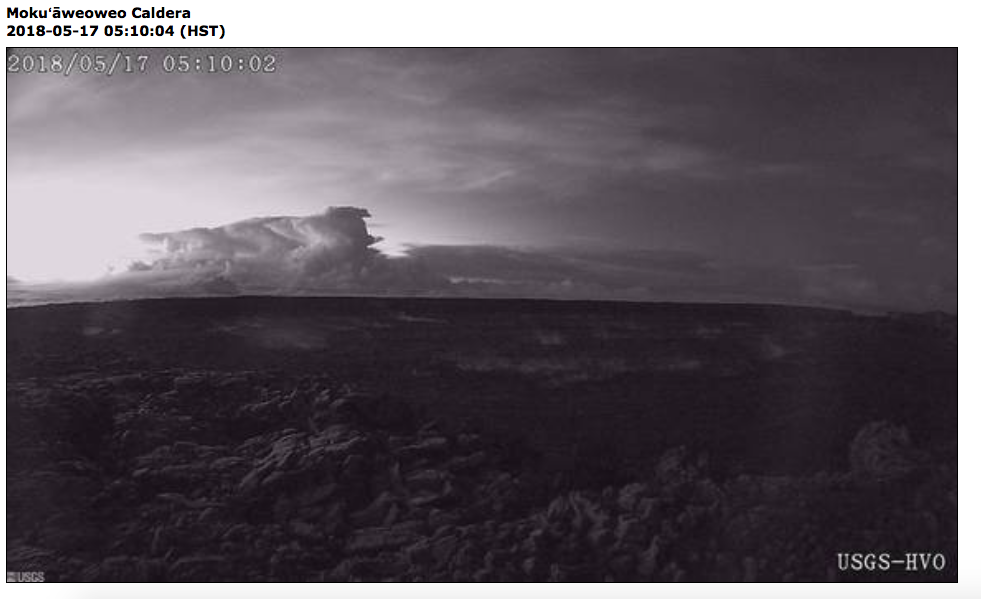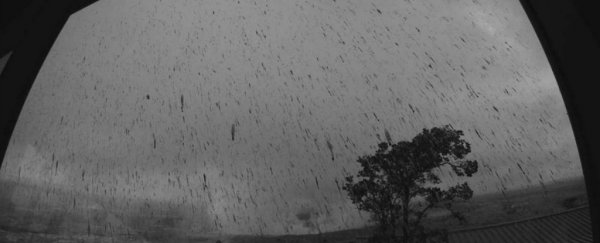Hawaii's Kīlauea volcano erupted explosively early Thursday, tossing boulders hundreds of feet and sending a plume of ash about 30,000 feet (9,144 metres) into the predawn sky.
A webcam at the Hawaii Volcano Observatory caught the aftermath of the short-lived eruption: an onslaught of wet, dusty ash raining on a darkened landscape.
From the summit of Mauna Loa volcano, 20 miles (32 km) away, cameras photographed an anvil-shaped plume billowing on the horizon.
In a news conference, scientist Michelle Coombs of the US Geological Survey said the activity could become explosive again.
"It's a real dynamic situation up there," she said of the summit.
 View of the ash plume (USGS)
View of the ash plume (USGS)
Scientists had warned for days about a major eruption as the lava lake that once filled the crater at Kīlauea's summit began draining back into the ground.
Their concern was that the sinking molten rock would create steam as it interacted with the water table and that the steam would then jet upward, hurling heavy rocks and ash into the sky in a phenomenon known as a phreatic eruption.
"This is the sort of explosive activity that was anticipated," said USGS geophysicist Mike Poland, who was based at Kīlauea from 2005 to 2015. "It's not going to be the only one. Very likely there will be additional events."
Hawaii Volcanoes National Park officials said the caldera - the depression at the center of the volcano - dropped more than three feet (90 cm) overnight, triggering frequent earthquakes that have cracked highways in the area.
As the caldera sinks further, it may set off additional steam-driven explosions, they said.
Though dramatic, Thursday's eruption at 4:15 am local time did not pose an immediate threat to people in the vicinity, Poland said.
Observatory staff had left their Kīlauea station Wednesday, for a facility at the University of Hawaii at Hilo, after concluding that wind could carry ashfall their way.
According to Poland, the greatest impact was to an area within a few hundred yards of the summit's eruptive vent.
That's where the explosion would have sent hot gas and 1,000-pound (450 kg) rocks soaring. For this reason, the national park has been closed since last week.
Wind is already carrying the plume from the eruption northeast, raining ash into nearby communities. Broadcasting on local radio stations, Hawaii Civil Defense officials warned that ash poses the main health threat from the eruption.
Residents were instructed to shelter in place if they found themselves in the path of the plume.
Depending on weather conditions, the USGS said, ash might fall as far as Hilo, 30 miles (50 km) to the northeast.
The observatory also warned that vog - a noxious smog formed when sulfur dioxide from eruptive vents interacts with water vapor and oxygen in the air - has been reported in the community of Pahala, southwest of the volcano.
Meanwhile, stormy weather caused the ash to mix with rain, creating a dark paste that coated rooftops and car windshields.
In the village of Volcano, barely three miles from the summit, lifelong resident Lance Benevides went through the familiar protocol to cope with an eruption, including detaching his roof gutters from his water tank to keep ash out of the catchment system that serves as his water supply.
Then he headed to the Volcano Store, a local gathering spot, where he sat with friends and sipped coffee Thursday morning - a ritual not even Kīlauea could disturb. "We all live in a circle around this volcano," said Benevides, 55. "So we know what to do."
USGS scientists use Ash3D computer simulations to show how far ash might travel and how much ash might fall to the ground. This graphic shows today's simulation (May 17) for the explosive eruption at Kīlauea’s summit. https://t.co/Ds1pWnFRVw pic.twitter.com/hGCoTBon1X
— USGS Volcanoes🌋 (@USGSVolcanoes) May 17, 2018
Though disruptive, even painful for people living near Kīlauea - especially those who have already lost their homes - the eruption will not significantly affect life on the rest of the Big Island, Poland said.
"And it is not likely to turn into some catastrophic event," he added.
Kīlauea, a massive shield volcano on Hawaii's Big Island, is the site of the world's longest ongoing eruption, one that has oozed lava since 1983.
But in recent weeks the volcano has become particularly restless. About 20 fissures opened in communities along the volcano's eastern slopes, prompting evacuations of nearly 2,000 residents and engulfing dozens of homes in lava.
In another news conference Thursday, the deputy scientist in charge of the Hawaii Volcano Observatory, Steve Brantley, said the lava flows in the east rift zone have slowed in recent days.
But observatory instruments have recorded "extreme deformation" of the ground in that area. One GPS instrument moved half a foot in 24 hours, a sign of the turmoil in the earth below.
"It's an indication the rift zone is being forced apart," Brantley said.
All that activity along the east rift zone caused a dramatic depressurization of the magma column below Kīlauea's summit, slowly draining the lava lake in the summit crater. In recent days, smaller eruptions there sent ash surging into the sky.
But those events were "not the big one" caused by interactions between hot rock and ground water, Coombs said Tuesday.
Thursday's event was, if not the big one, then certainly a big one, researchers said.
As the molten rock dropped below the level of the water table, it's likely that water in the surrounding rock began pouring into the vacated chamber - much the way water rushes to fill a recently dug well, said Charlotte Rowe, a geophysicist at Los Alamos National Laboratory.
The water would then flash into steam, "and steam as we know is a very powerful source of energy, a very powerful propellant," Rowe said.
Kīlauea has erupted in this manner before. In May 1924, the Hawaii Volcano Observatory reported more than 50 explosive events over the course of two-and-a-half weeks at the volcano's summit.
The lava lake had drained from the summit crater several months earlier - the scenario now being repeated. The eventual eruptions generated ash clouds more than five miles (8 km) high and threw blocks weighing as much as 28,000 pounds (12,700 kg) out of the crater.
One person was killed by falling debris from the largest eruption.
Coincidentally, Thursday's explosive event comes one day before the 94th anniversary of that death and on the 38th anniversary of the 1980 eruption of Mount St. Helens in Washington state.
What is happening at Kīlauea is fundamentally different from that 1980 eruption, experts said. Shield volcanoes like Kīlauea produce a runny, basaltic lava that does not tend to erupt as dramatically as steep stratovolcanos like Mount St. Helens.
Whereas St. Helens sits along the geologically active boundary of the Pacific Plate, Kīlauea and the other Hawaiian volcanoes are powered by a hot spot deep within Earth's mantle.
But phreatic eruptions can still pose a deadly threat to anyone near the eruptive vent - and they are extremely difficult to forecast, Poland said.
Eruptions involving magma offer warning signs for a potential evacuation, including inflation of the surrounding ground, seismic activity caused as rocks break and changes in the gases being vented.
Phreatic eruptions are "much more random," Poland said. More than 30 people were killed when a 2014 phreatic eruption at Japan's Mount Ontake caught them unaware near the summit.
In addition to monitoring the volcano's current activity, researchers are scouring data from Kīlauea's extensive monitoring network - of tiltmeters, seismometers, and ground and aerial gas detectors - in search of any changes that preceded Thursday's event.
Their hope is to pinpoint warning signs that could be used to predict phreatic eruptions in Hawaii and elsewhere.
2018 © The Washington Post
This article was originally published by The Washington Post.
